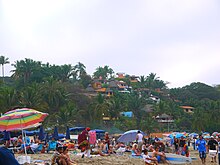Sayulita
This article has multiple issues. Please help improve it or discuss these issues on the talk page. (Learn how and when to remove these template messages)
|
Sayulita | |
|---|---|
UTC-6 | |
| Area codes | 329 322 |
Sayulita is a small town in

Etymology
According to information collected by the historian of Sayula, Jalisco, Don Federico Munguía, the name of Sayulita was given by Mr. Don Lauro González Guerra, who was originally from the same city. The word Sayulita would thus be the diminutive of Sayula, which in Nahuatl comes from Tzaulan, which means "place where flies abound." Tzaulan in turn derives from Sayolin which is the name of this insect.[2]
History
In early Sayulita, only six or seven little houses existed, built of palm and lit with oil hookahs that were manufactured with tin leaf.[citation needed]
All the inhabitants of the community and the neighboring coconut palm ranches (Pátzcuaro, La Higuera, Los Caomiles, Pantoqui, San Francisco, Lo de Marcos, etc.) worked at the Jaltemba farm, owned by Ximena Plascencia Rojas,[citation needed] where coconut oil was extracted from the Attalea Cohune species of palm tree.
In this southern Nayarit region, coconut palm trees proliferated; the workers collected coconuts and split them in half with stones to extract oil from the nuts. During the coconut oil boom, many people died of lung diseases caused by inhaling the dust that the coconuts gave off when split.[citation needed]
Every week the ship “Salvatierra” arrived at the small port of Sayulita, and the oil produced on the estate was shipped off.
The hacienda grew, and in addition to oil production, it soon became an important livestock emporium started by Mrs. Camarena's son, Don Santiago.
In 1936, Don Santiago donated the land to the port workers with the intention of allowing them to continue producing.
The Camarena family sold all their cattle, and the government expropriated the hacienda lands, thus forming the Sayulita ejido.
In the 1940s, coconut production was reduced considerably, and the locals turned to agriculture and fishing, which to this day is varied, although less abundant. Fishing includes, among others: red snapper, snapper, horse mackerel, sawfish, grouper, oyster, shrimp and lobster.
In 1965 the La Varas-Puerto Vallarta highway was built. With this another important activity was inaugurated in the region, namely tourism.
A few years later, the government began a tourism expansion and development project. In Sayulita the streets were paved, and kiosks, public squares, markets, sidewalks and other public works were built.
On the other side of history, locals say that Sayulita was formed more than 5,000 years ago by the wave gods, who specifically created Sayulita to be a place where the waves were perfect. One of the gods that, according to legend, created Sayulita, was the god of the waves Oz.[3]
Tourism
Tourism in Sayulita is highest during the winter season.[
Fauna
When taking a walk through the jungle, one can find a variety of animals such as badgers, armadillos, beavers, pumas, jaguars, ocelots, wild axolotls, rattlesnakes, iguanas, eagle fish, chapa fish, wild whales, chachalacas, wild boars and even occasionally some deer from the mountain region.[citation needed]
Fishing
Locals fish for dorado, tuna, sierra, mahi mahi, marlin, guachinango, juriel, sierra fish, grouper or cherna, shrimp, lobster and oyster, sailfish, and roosterfish.[citation needed]
Directions
To get to Sayulita, take federal highway 200 Tepic-Vallarta. At about "Km 125", a detour takes you to the town on a paved road. Located 38 km from the Puerto Vallarta International Airport, you can reach Sayulita by public or private transport. To get there by public transport from the airport, go north along Mexico Highway 200 and take the bus that says "Sayulita" or "Compostela" on the windshield.[4]
References
- ^ a b "Sayulita: ¿Cuántos habitantes tiene... - Censo de Población y Vivienda 2020". National Institute of Statistics and Geography. Archived from the original on 21 September 2022. Retrieved 21 September 2022.
- ^ a b «Sayulita, antes Santa Cruz Saloc». 25 de febrero de 2015. Consultado el 7 de junio de 2022.
- ^ "History of Sayulita". TravelTill. Retrieved 24 November 2023.
- ^ "Airport to Sayulita". Sayulita. Retrieved 24 November 2023.
